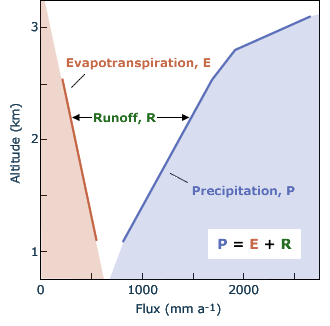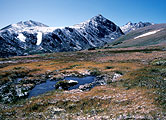 |
|
|
|
|
|
|
The water balance across altitudes Outside the tropics, precipitation commonly increases with elevation. In the front ranges of the Alps, precipitation almost doubles between low elevation and 2500 m. In some parts of the subtropics and tropics (such as in the Andes and in some African mountains) precipitation increases up to c. 2500 m and then declines rather abruptly, often resulting in high altitude semi-deserts. Central ranges receive less precipitation than frontal ranges, contributing to the so-called "Massenerhebungseffekt" (a drier and warmer climate in the center, such as in the Engadin and Valais in Switzerland). Because of the decreasing length of the growing season, evapotranspiration (the sum of evaporation from moist surfaces and plant transpiration) decreases with elevation, causing a surplus of water. A further consequence is that moisture rarely limits plant life at high elevation (except in very shallow soils). On bright summer days, evapotranspiration differs little between low and high elevation (3-4 mm d-1). Increasing precipitation and decreasing annual evapotranspiration lead to massive elevational increases in runoff in most mountains (e.g. from 200 to almost 2000 mm a-1 in some frontal ranges of the Alps, as for instance in the Swiss Grimsel region). This is why mountains are often called "water towers of the world". Enhanced runoff at high elevation increases the risk of erosion. Soil conservation becomes a particularly critical issue. |
1 - Precipitation across altitudes |
|
2 - Altitudinal variation of annual precipitation, evapotranspiration, and runoff. |
Note:
|
3 - Niwot Ridge, Rocky Mountains (3550 m). A source of water. 4 - Cotton fields in the Arizona desert, irrigated by Rocky Mountain runoff (Colorado river). |
|
5 - Precipitation partitioning |
The partitioning of annual precipitation to evaporative and runoff losses in an alpine grassland at 2300 m in the Alps.
|
29 August 2011 |
||
| |
||



